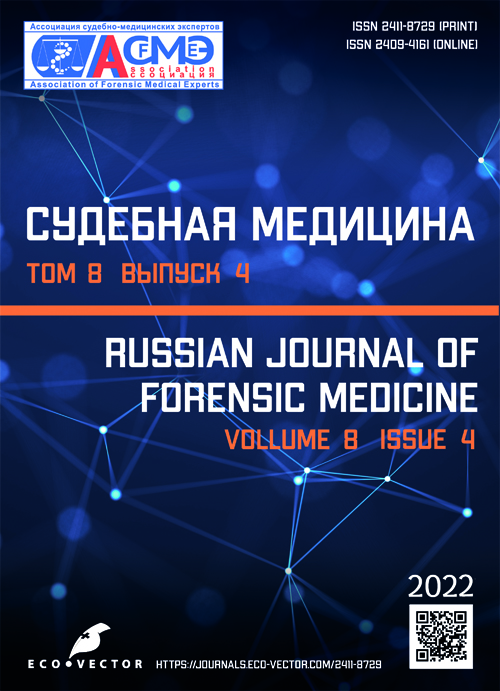卷 8, 编号 4 (2022)
- 年: 2022
- ##submission.datePublished##: 17.12.2022
- 文章: 11
- URL: https://for-medex.ru/jour/issue/view/36
- DOI: https://doi.org/10.17816/2411-8729-2022-8-4
原创研究
下颌骨结构中与年龄有关的变化的放射形态学评估
摘要
目的。本研究的主要目的是利用全景数字成像技术,确定、比较和区分不同年龄段的男性和女性自然牙齿志愿者的下颌骨结构的变化,并确定由此获得的数据在年龄评估中的可靠性,以支持法医意见。
材料与方法。我们对620名志愿者进行了下颌骨的全景数字成像,分四个年龄组:12-18岁、19-40岁、41-60岁和60岁以上。我们测量并分析了下颌角、下颌骨髁突长度、下颌骨分支长度、皮质骨厚度和下颌骨分支切口宽度。数据的处理采用了描述性的统计分析方法,以及双侧学生t检验和双因素方差分析。
结果。角度和四项线性测量显示,所有年龄组之间的差异具有统计学意义(p<0.05),除下颌角外,所有测量都有以下规律:年龄组越大,差异越大。左右两边的所有参数(下颌角、下颌支长度和下颌支切口宽度)都有统计学上的显著差异(p<0.05)。
结论。研究人群中,根据下颌骨的角度和线性测量来估计年龄的可能性已被证实。研究发现,除下颌角外的所有参数都能可靠地确定年龄,年龄越大,所有参数的平均值越大,对于除下颌角外的所有参数,发现有统计学上的显著差异。因此,根据这项研究的结果,可以建议在法医检查中使用除下颌角以外的所有参数进行年龄评估。
 5-14
5-14


急性巴氯芬中毒及其与乙醇的结合对大脑皮层神经元的损害
摘要
论证。使用肌松剂巴氯芬的中毒事件最近有所增加。巴氯芬中毒的目标器官之一是大脑。
该研究的目的是检测和量化巴氯芬中毒及其与乙醇结合时的皮质神经元损伤。
材料与方法。对大鼠大脑皮层进行了组织学检查。对照组(n=5)既没有接受巴氯芬也没有接受乙醇。实验组1和3(n=5)的动物接受巴氯芬(85毫升/公斤),而2和4组(n=5)的动物接受相同剂量的巴氯芬和乙醇(7毫升/公斤)的组合。第1和第3组的动物在4小时后退出实验,第2和第4组的动物在给药一天后退出。组织学准备用苏木精和伊红以及Nissl染色,并通过光镜检查(×400)。对有损伤的神经元数量进行计数。采用非参数的曼-惠特尼方法对数据进行统计处理。
结果。对25只大鼠的大脑皮层进行了组织学检查。对照组有13%的神经元有可逆转的变化,9%的神经元有不可逆的变化。当4小时后施用巴氯芬时,可逆变化为22%,不可逆变化为21%。在同一天,巴氯芬和乙醇的联合给药导致了可逆(24%)和不可逆(29%)的神经元变化的增加。服用巴氯芬一天后,可逆的神经元变化的比例为25%,不可逆的为37%。当巴氯芬和乙醇共同注射时,具有可逆(27%)和不可逆(41%)变化的神经元含量增加。统计结果显示,与对照组相比,4小时后有明显的变化,24小时后,与对照组和4小时后得到的结果相比,都有统计学上的显著差异。
结论。了解巴氯芬中毒及其与乙醇结合所涉及的大脑过程,将能够对这类伤员提供最有效的护理。检测到的大脑神经元损伤的迹象,以及法医化学分析的结果,可用于证实此类案件的直接死因。
 15-24
15-24


利用逻辑回归方程从牙齿测量特征确定一个人的性别
摘要
论证。开发适应阿塞拜疆人口诊断的骨质鉴定技术是一个优先事项。一种从牙齿上快速确定性别的新方法似乎很受欢迎,因为它应该能提高法医学的效率。
该研究的目的是开发一种现代方法,通过牙齿测量特征来诊断人类性别。
材料与方法。阿塞拜疆人的颅骨收藏被用来研究他们牙齿的大小。三个参数在7个上颚和7个下颚的牙齿上进行测量(对称的牙齿被当作一个阵列)。14颗解剖学牙齿中的每一颗都由80颗男性和80颗女性牙齿代表。使用Mutitouyo数字卡尺(精度为10微米)进行牙齿测量。采用ROC分析法对牙齿测量的结果进行了统计分析。MATLAB统计软件包被用于数学建模。
结果。使用ROC分析检查了在测牙期间获得的数据。发现有六个牙齿测量特征与性别有关,其中上犬牙的颊舌径和第二下臼齿、下门齿、下犬牙和上内侧门齿的冠高与性别关系最大。利用数学模型,已经实现了6个逻辑回归方程,可以通过牙齿的大小来确定个体的性别。还用ROC分析评估了这些方程式的预测潜力。
结论。根据牙齿测量指标并使用ROC分析,得出了通过牙齿大小来确定一个人的性别的诊断方程式。这些方程还没有在独立的样本上得到验证,所以还不能明确地推荐它们用于实际应用。然而,由于作者使用了相当强大的数学仪器,他们依靠自己的模型的高度合法性。
 25-36
25-36


自杀死亡率演变的回顾性法医分析
摘要
论证。在世界许多国家,与多种风险因素有关的已完成的自杀人数越来越多,这令人担忧。根据不同的研究人员,完成自杀的发生率在两个性别之间有很大的不同。
该研究的目的是研究已完成的自杀事件中不同性别的死亡率。
材料与方法。对死亡率的分析是通过对1992-2019年期间该国法医机构活动的官方报告信息进行回顾性统计分析来进行的。
结果。对包括自杀在内的暴力死亡的回顾性分析表明,自杀作为一种现象有其自身发展的规律性特征,特别是指标的周期性变化(上升、下降、波浪式的过程),其特点是有一定的周期性、恒定性(在全国范围内现象的稳定性)。研究期间,已完成的自杀事件占尸体检查总数的14.0%,占所有暴力死亡事件的21.4%。对按性别划分的自杀死亡绝对人数的分析表明,男性群体的自杀人数明显占优势——33888人,而女性群体为16036人,分别占67.9%和32.1%。男女组中完成自杀的绝对数量之比约为2:1。自杀死亡率表明,该国的自杀现象的性质是永久性的和持续的。
结论。1992-2019年期间乌兹别克斯坦完成自杀的研究结果表明,完成自杀作为一种现象有其自身的发展模式。这些是变化的恒定性(现象出现的稳定性)和周期性(指标状态的周期性变化——上升、下降、以一定周期性为特征的波浪式流动)。
 37-46
37-46


高效液相色谱-串联质谱法检测中毒患者尿液中的氯巴扎姆及其代谢物
摘要
论证。确定氯巴扎姆的急性和致死性中毒事实的问题仍然是分析毒理学的一项紧迫任务。药物氯巴占属于苯二氮卓类药物,由于其在过量和滥用的情况下具有高毒性,因此被列入限制流通的精神活性物质清单中。
该研究的目的是提出一种简单、可靠和敏感的技术,通过现代高效液相色谱-串联质谱检测(HPLC-QqQ-MS/MS)鉴定尿液中的氯巴扎姆及其代谢物。
材料与方法。我们描述了一种简单而敏感的HPLC-QqQ-MS/MS方法,用于定性检测尿液中的氯巴扎姆。
结果。根据研究结果,在选定的色谱条件下,氯巴扎姆的保留时间为5.17分钟,而在尿液中发现的其代谢物(去甲氯巴扎姆)则为4.56分钟。氯巴扎姆最强烈的(主)峰是259 m/z,诺拉扎姆是245 m/z。
结论。首次提出了一种经过验证的HPLC-MS/MS方法,用于调查氯巴扎姆中毒的化学毒物学。在一个模型混合物和一个病人服用氯巴扎姆后的尿液的真实生物基质上都得到了验证。这种技术作为一种确认性检查技术,是对法医临床情况的一种补充。
 47-55
47-55


行驶中自行车车身侧面被其他车辆撞伤的骑车人损伤特征
摘要
论证。自行车伤害作为一种单独的交通事故类型,需要法医检查以确定伤害的机制、持续时间和严重程度。文献中没有充分涵盖骑车损伤的法医方面。
该研究的目的是研究当其他车辆撞到行驶中的自行车侧面时受伤的骑车人受伤形成的性质和特征。
材料与方法。分析了因车辆与行驶中的自行车发生侧面碰撞而死亡的骑车人(n=51)的法医检查结果。
结果。骑车人最常观察到的损伤是颅脑损伤(21.56%)和复合损伤,包括头部和胸部损 伤(15.68%)、下肢损伤和头胸部损伤(11.76%)。几乎所有(96.0%)死亡的骑车者都有头部受伤,其特点是严重的脑挫伤和顶骨、颞骨和枕骨的骨折。胸部结构和胸腔器官的损伤也很常见,占50.69%的病例,肋骨骨折占74.2%。在20.15%的病例中发现了肝脏破裂和器官韧带出血等形式的腹部器官损伤。小腿和股骨也有骨干粉碎性骨折。
结论。其他车辆与行驶中的自行车的侧面碰撞中死亡的骑车人最常见的伤害类型是创伤性脑损伤,以及头部和胸部损伤和下肢骨折合并头部和胸部损伤。头部结构病变的特点是顶跗骨和枕骨的线性、凹陷性骨折。胸部结构伤害的特点是上肋骨骨折和肺部挫伤。躯干的前外侧部位观察到类似于“路疹”模式的皮损。双侧骨干粉碎性骨折多见于下肢,主要是小腿骨。
 57-65
57-65


科学评论
研究不同厚度刀柄的刀刃造成的平骨刺伤的前景
摘要
锐器伤害占锐器造成的所有伤害的一半以上。
过去几十年,法医学的科学研究一直致力于法医创伤学,这可以从涉及机械损伤的专家检查的数量稳步增长中得到解释。在此期间,基于材料切割的理论,研究并总结了刺伤的机制和生物力学方面的信息;描述了刺伤骨的个别形态特征。在法医检查过程中,根据受害人的软组织损伤和衣服要素,对识别刺杀和切割武器的可能性进行了充分的调查。
对文献的回顾表明,目前专家们认为刀柄是刀片的一个伤害性部分。在识别刺伤和割伤的痕迹时,会使用“削尖的地方”这样的术语来描述它们。我们认为,现有的文献已经充分研究了由于对小腿肋骨软、硬组织的冲击而形成的痕迹过程,但对小腿粗细不同的刺伤骨骼的形态,显然研究得不够充分。
为了提高对刺杀和切割物体造成的扁骨损伤的法医诊断,需要进一步对剖面材料进行实验研究,以详细研究形态特征的复杂性。
 67-75
67-75


电动滑板车和相关伤害:法医
摘要
对活人的检查以及对涉及轮式车辆事故中尸体的检查仍然是法医专家的首要任务之一。在过去的3-5年里,个人移动辅助工具变得越来越普遍,它们的使用自然导致了道路事故的增加。
迄今为止,关于汽车、摩托车甚至自行车伤害的报道已经相当多了。然而,在国内法医文献中没有关于自残的数据,这一点在国外作者的作品中无法体现。
本文献综述提供了一些流行病学数据,以及涉及电动滑板车的伤害案件的机制和类型的信息。介绍了一些关于道路事故的统计数据,包括死亡人数。滑板车伤害的特点是具有季节性,主要在一年中较温暖的月份(夏季、初秋)有增加的趋势。特别容易受到伤害的是直接操作电动滑板车的年轻人,通常是男性。跌倒被认为是最主要的事故类型。身体上最“受 创”的部分是头部和四肢。伤害通常是孤立的,可以是外部(擦伤、瘀伤、伤口)或内 部( 骨折)。滑板车伤害中的内脏伤害是极其罕见的。
 77-88
77-88


临床病例报告
使用计算机断层扫描结果诊断活人刺伤的可能性
摘要
目前计算机和磁共振成像等现代研究方法已被引入大型医院的医疗和诊断实践中。这些研究方法几乎在所有地方都被用于诊断各种类型的伤害,其结果连同受伤者的医疗文件,由执法人员和法院提交给国家法医机构进行法医检验。对计算机和磁共振成像结果的研究使您能够解决活人检查和研究案例中的专家问题。
本文介绍了一个专家实践案例,展示了利用活体计算机断层扫描和三维建模的结果确定刺伤的形态特征和定位、创伤效应的数量和伤口通道方向的可能性。在所描述的专家案例中,提交的医疗文件最初包含关于受害人伤口的数量、位置和形成机制的相互矛盾的信息。为消除存在的矛盾,入院时对受害人身上的伤疤进行了检查,并在医疗机构对受害人进行了CT扫描。为了更完整地可视化外部伤害,根据计算机断层扫描数据重建了受害者身体的三维模型。作为这项研究的结果,有可能清楚地重现受害者所受伤害的画面,并回答有关他们造成伤害的机制和条件的问题。
所描述的案例展示了专家研究和解决法医问题的新方法的可能性,这是目前非常相关的,因为近年来,法医学一直在积极开发尸体验尸技——virtopsy。文章中描述的研究方法可以应用于带有刺伤的尸体,这可能会更准确地显示伤口通道的方向和形状。
 89-96
89-96


恶性高热的临床和形态学特征:一例来自实践的罕见病例
摘要
现代全身麻醉最严重的并发症之一是恶性高热,表型表现为高碳酸血症、窦性心动过速、骨骼肌代谢亢进和横纹肌溶解或在使用吸入麻醉剂和非去极化肌肉松弛剂进行全身麻醉后。恶性高热症最常见的初始迹象是呼气结束时二氧化碳浓度突然上升。这种药物遗传性疾病的非典型形式比暴发性形式更常见。在俄罗斯恶性高热症的问题目前仍未得到解决。
作者描述了一例19岁女孩的恶性高热,她在使用西维兰麻醉下接受了鼻腔呼吸障碍的手术。由于出现了临床诊断的恶性高热,患者在离开麻醉状态1小时25分钟后死亡。法医尸检证实了这一诊断。使用观察性和选择性的组织学染色来描述骨骼肌的形态学变化。
所提出的观察值是由于雷电引起的恶性高热症的罕见性和伴随这些病理变体的高死亡率。这个专家案例展示了一个合格的、全面的组织学检查,包括使用基因测试,可以正确制定诊断,并在必要时对执法当局的问题作出合理的回应。
 97-104
97-104


协会新闻
第二届区域间协会科学和实践会议“病理解剖和法医检查的放射诊断:从生前到死后”
摘要
我们对区域间死因放射性协会的第二届科学和实践会议“病理解剖和法医专家的放射诊断:从生命期到死后”进行了简要报告,会议于2022年10月7-8日在莫斯科的A.P. Avtsyn人体形态学研究所、联邦国家科学机构“B.V. Petrovsky俄罗斯外科科学中心”举行。
 105-110
105-110












